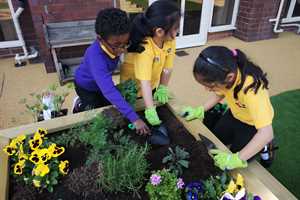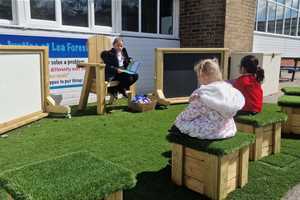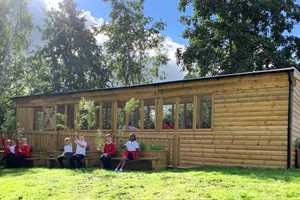
Outdoor Learning and Play
The Benefits Playground Planters Bring To Your Playground And 5 Nature-Oriented Lesson Ideas for Your School
We reveal the educational benefits that a Planter Bench can bring to your school playground with 5 great lesson plans to help introduce children to a variety of topics
Planter Benches are a fantastic resource to have in the school playground; far from being merely a social seating solution, the benefits of these ingenious planting boxes reach across a broad range of curricula subjects.
As we raise our children to make the most of every moment, encouraging them outdoors to absorb the wonders of each season, here are just a few lesson plans that will help your children embrace certain seasons while utilising your Planter Benches to introduce the children to key topics.
%20-%20Straight%20Planter%20Bench.jpg)
Express Yourself – English (poetry – creative writing)
What better way to stimulate the children’s creativity than to take the class outside and let them draw ideas from the nature around them.
Seat the children on the Planter Benches, asking each one in turn to call out a word that they associate with what they can see; it’s essentially just verbal brainstorming.
This lesson can be easily adapted to help children develop both their spelling and memory skills by asking them to quietly recall all the words they heard before writing them down to create a seasonal vocabulary list.
Continue this lesson by splitting the class into little teams so that they may collectively work on a seasonal inspired poem, using the terminology lists they’ve just created to help them along the way.
An alternative to this lesson would be to allow the children to work independently on acrostic poems, setting a challenge to see who can incorporate most of the words from the brainstorming session.
A – amber foliage glowing in the sun
U – unadulterated fun as we jump through the crunchy leaves
T – transformations all around
U – unpredictable winds
M – magnificent colours
N – nights are getting colder
S - sparkling water reflects off the sun
P - picture perfect surroundings
R - refreshing mornings bring smiles to faces
I - invigorating blossom sweet taste
N - not a cloud in sight
G - green grass brightens up horizons
%20-%20Quad%20Seat%20Planter.jpg)
The Observer – Geography / Science
While, for the most part, children love working in teams, they also like to be recognized as having been responsible for a particular element of a group project and feeling like their input mattered; creating a newspaper is the perfect way to get this balance.
Divide the class into units that are small enough to accommodate everyone having a specific role and advise them to come up with a good name for the meteorological publication that they’re going to produce.
%20-%20Low%20Level%20Planter.jpg)
This project can be spread over several weeks, giving rise to more opportunities for the class to be taken outside at different times of the day, so as to allow for a greater number of observations of the natural elements i.e. air temperatures, cloud formations, types of precipitation and wind speeds - your Planter Benches will be a great base for all the teams as they work on their newspapers.
While the printed publications will be presented to the class as a group effort, each team member will be recognized by having their names printed beneath the articles, illustrations and photographs that they contributed.
Not only an extremely enjoyable way to introduce this part of the Geography and Science curricula, this project will undoubtedly help the children improve both their spoken and written language skills while also encompassing parts of the art syllabus.
Capture the Colours – Art
Sometimes it’s hard to feel inspired when sitting inside a classroom so why not take the children outside to feast their eyes on the seasonal colours that surround them – who wouldn’t feel motivated to pick up their pencils to capture nature’s seasonal changes?
Your Planter Benches are perfect for such lessons as the children can choose whether to sit facing outwards and observe the distant flora or kneel inwards to focus on the detail of the bedded plants.
This will prove a great opportunity to introduce the children to important art techniques as they try to replicate the intricate patterns and textures of the leaves and bark that they’re observing. There is no doubt that the rich shades of the outdoors will encourage some beautiful drawings.
Allowing children the occasional dash across the playground to collect some of the fallen leaves will not only enable closer inspection of the finer details but will certainly add to the fun.

Leaf Count – Mathematics
Split the class into small groups, of perhaps 3 or 4 children, before drawing up a daily rota that spans a four week period.
When the children go outside for their daily break, the group that is scheduled for that particular day must conduct an accurate count of all the leaves that are still attached to the plants contained within the planter box, carefully recording the figure against the relevant date on the rota chart.
The conclusion of this task will see the children generating bar graphs to represent the collected data, which they will then use to answer related word problems that you generate for them. This is a fabulous, and very interactive, way to teach your class about how data can be stored and used.

Link Me A Story – English
Far from always being inherent, creativity can often be inspired by those around us; it could simply be that we need to see/hear the ideas of others to give us the confidence to openly express our thoughts and freely interpret our ideas.
Take your whole class outdoors to put this into practice – it’s a good idea to sit the class around the Planter Benches as this will enable the children to see their surroundings.
Drawing on what you see, the teacher may start off a story with a simple short sentence before asking the child seated next to her to add on a little bit more. This pattern continues, each child adding a sentence so as to build on the story, until everyone in the class has made a contribution.
You may wish to use this lesson purely for creativity and repeat this story making process several times, starting each new narrative with an interpretation of what you can see around you and giving the children the first notion on which to construct their story around.
With creative imaginations now in full flow, why not take the opportunity to introduce adjectives to maximise the impact of each sentence or add punctuation to make the story a more dynamic read. The possibilities for extended learning are vast with this fun packed lesson.



 - Straight Planter Bench.jpg)


